The Formation of the Sino-Tibetan Languages and their Speakers Migration
The Formation of the Sino-Tibetan languages and their Speakers Migration
The Sino-Tibetan family consists of about 300 languages, which immediately casts doubt on the possibility of studying them by the graphical-analytical method, without pre-classification them by methods is purely linguistic. This problem is still not fully resolved, but seven of these languages were singled out by the project "Tower of Babel" and their etymology was presented there in tabular form.
Such a representation allowed us to reflect on the relationships of these languages in a graphic form. In total, the database included 2,775 roots for the following languages: Chinese, Tibetan, Burmese, Kachin, Lushai, Lepcha, and Kiranti. 91 roots from them can be considered common to all these languages, and 174 occur in only one of them. All of them were excluded from the list that was used for counting the number of common words in pairs of languages. These data are shown in the table.
Table 1. The amount of common words between the Sino-Tibetan languages
| Language | Chinese | Tibetan | Kachin | Burmese | Lushai | Kiranti | Lepcha |
| Chinese | 1704 | ||||||
| Tibetan | 920 | 1393 | |||||
| Kachin | 716 | 548 | 1262 | ||||
| Burmese | 736 | 621 | 595 | 1254 | |||
| Lushai | 546 | 445 | 440 | 240 | 1036 | ||
| Kiranti | 296 | 270 | 234 | 242 | 231 | 454 | |
| Lepcha | 264 | 253 | 222 | 106 | 209 | 94 | 425 |
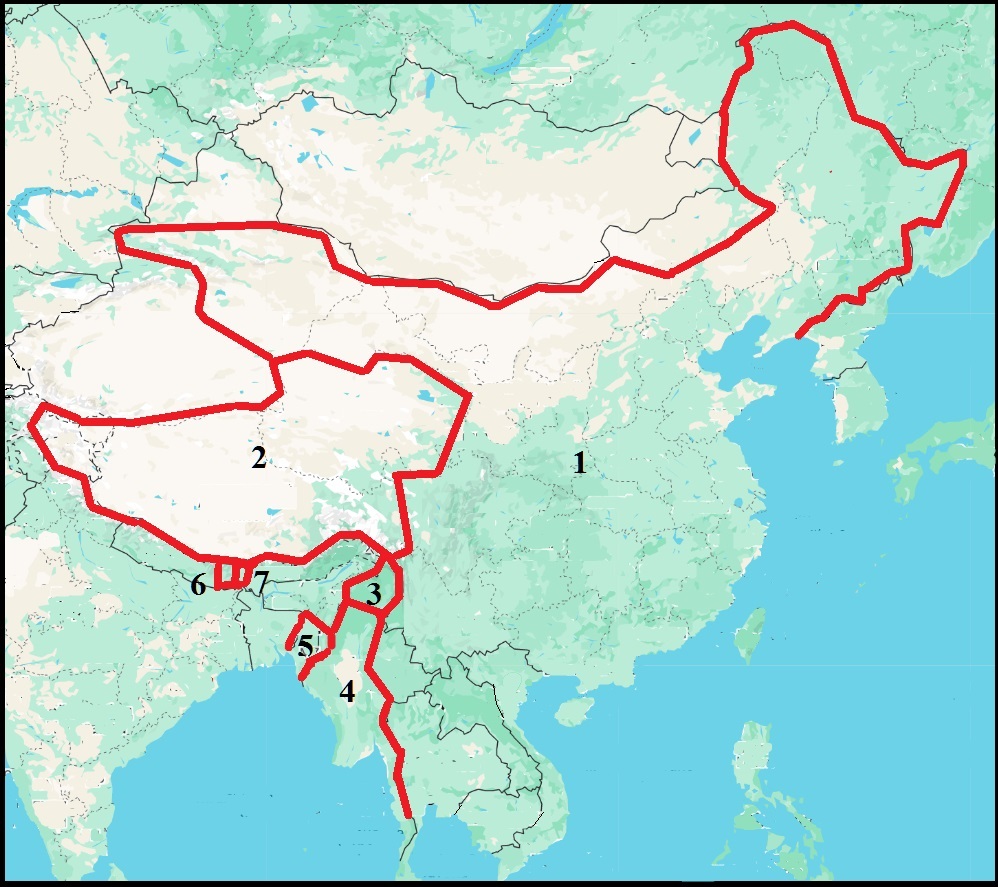
Right: Territories of dissemination of Sino-Tibetan languages
1 – Chinese
2 – Tibetan
3 – Kachin
4 – Burmese.
5 – Lushai
6 – Kiranti
7 – Lepcha
The total amount of words of each language taken for analysis is shown in the diagonal of the table. Immediately, the disproportion for the Kiranti and the Lepcha languages compared to the others is small. There may be various reasons for such disproportion. Perhaps these languages have not been sufficiently studied; maybe the ancestors of their speakers lived far enough away from the rest of the Sino-Tibetan in enclaves; maybe these are speakers among of another language family, or maybe these are lost part of an ancient vocabulary. There are other possible causes, but one way or another, the two languages do not fit into the graphical model of kinship Sino-Tibetan languages, although, of course, they are genetically closely related to them.
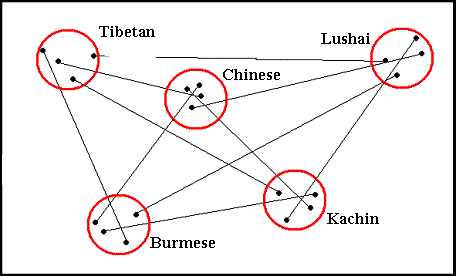
The graphic model of the relationship between the Sino-Tibetan languages is shown on the left. This version of the model (but not its mirror reflection) was chosen because it meets to some extent modern-day places of settlement of Tibetans, Chinese, and Burmese. As you can see, the points for each language are located fairly compactly. What testifies to the correctness of the lexical material is the adequacy of the representation of their kinship system. It was assumed that the Sino-Tibetan Urheimat was somewhere in Central Asia or the Far East. However, the search for a place on the map suiting this scheme there failed. There is no such place in this part of Asia at all.
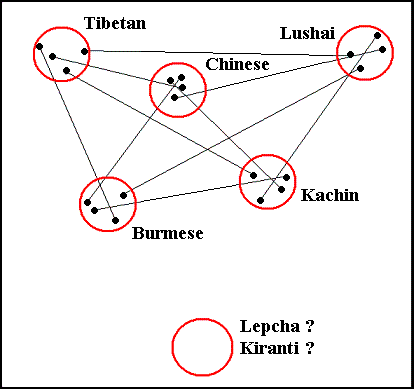
The scheme configuration bears a certain similarity to the scheme of the Nostratic languages, and thus both could be compared to each other provided that the Lepcha or Kiranti languages area were settled down southward to the Burmese and Kachin languages area. And there’s a rationale to that hypothesis, though, since the linguistic investigations illustrated, in some way, the compliance of the contemporary settlement areas of related peoples' crops to a certain extent to the location of their Urheimats at the time of their language formation.
Actually, the speakers of the languages Lepcha and Kiranti live closer to the Burmese than to the Chinese. The Lepcha are the indigenous people of the State of Sikkim, India located between Nepal and Bhutan. The Kiranti people are dwelling in Nepal. All this is not far from Burma but then, also from Tibet too. This suggests that the affinity of the Sino-Tibetan languages with the hypothetical arrangement of the Lepcha and Kiranti languages can be graphically reflected, as shown in the diagram above. If we compare this scheme with the scheme of the kinship of Nostratic languages, then their similarity does not raise objections (see the diagram below).
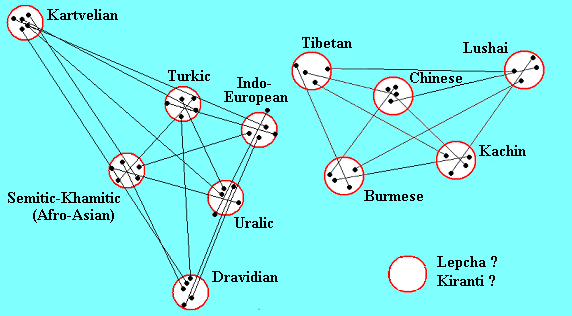 |
The comparison of the kinship models of the Sino-Tibetan and Nostratic languages
Accordingly, we have reason to locate the Urheimat of the Sino-Tibetans around the three lakes Van, Sevan, and Urmia in Asia Minor where we located the Urheimat of the Nostratic languages (see map below).
Thus, the Tibetan language was formed on the Plateau of Kars in the upper valleys of the Kura and Chorokh Rivers. The Chinese language was in the valley of the Aras River at Lake Sevan. The Urheimat of the Lushai people was located further downstream of the Aras. Burmese was formed near Lake Van, and Kachin was near Lake Urmia. Maybe the area in the valley of the Great Zab was inhabited not by the peoples of Lepcha or Kiranti. These settlements could be located in the eastern part of Asia Minor, considering their present settlement place and distant relationship with other Sino-Tibetan languages. The question of the placement of the ancestral peoples of the Lepcha and Kiranti peoples, as well as of the other peoples of the Sino-Tibetan language family, still needs to be clarified
It seems incredible that with the Near-Asian origin of the Sino-Tibetans belonging to the yellow race, this race could have formed somewhere near their modern places of settlement under the influence of local natural conditions and then spread over a huge space in a completely different environment. One can think so following logic, but the scientific world is inclined to this idea in the course of genetic research:
… many ‘ancient’ DNA markers being picked up outside of Africa and enlisted to argue for gene low from extra-African archaics.., could eventually turn out to be have been carried from Africa in modern human dispersals, followed by subsequent major frequency changes between Africa and the outside (STRINGER CHRIS. 2007: 17).
The idea of the Urheimat of the Sino-Tibetan people in Western Asia is not new. French scholar Terrien de la Couperie (1845-1894), the author of the book "The Early History of Chinese Civilization" found a distinct resemblance between the Chinese and the early Akkadian hieroglyphics. In addition, he demonstrated lexical correspondences between the Chinese language and the Babylonian dialect of Akkadian which was used by people in Chaldea. Another affinity found him was the correspondence between the Chinese and those of Elam and Chaldea. For example, the dragon-lion or unicorn combining the body of a feline with the head of the horned viper specific to the Oxus Civilization and the Indus is present in Chinese iconography (CAUBET ANNIE. 2021, 208).
These discoveries lay the basis of his theory about the Elamite origin of the Chinese forefathers. He found many place names that could be traced en route that some tribes have come from Western Asia to the Yellow River Valley. C. J. Ball developed and supplemented the research of Terrien de la Couperie and tried to convince the learned world about the Western origin of the Chinese system of writing and the connection between Chinese and ancient Accadian languages. In the future, several arisen theories pointed the Chinese Urheimat to Babylonia or even to Egypt. However other scholars, for example, Herbert A. Giles, considered Couperie's theory as nonsense (AYLMER CHARLES, 1997: 25) and E. H. Parker saw no connection between Chinese and Akkadian or Egyptian forms of writing (WILLIAMS E.T., 1918, 208).
E. T. Williams considered in detail the theory of the Chinese Urheimat in Central or Western Asia in his article "The Origins of the Chinese" published in "The American Journal of Anthropology" in 1918. He noted that it was difficult to separate the facts given by Terrien de la Couperie and his guesses but he was certain that de la Couperie's theory "enables us to give a very satisfactory explanation of the striking similarity between the language of ancient China and that of the Sumerians and the still more striking similarity between the ideographic symbols of the two peoples"
Since during the migration of the peoples, some portion of them remained always on former habitats, then, assimilated by Caucasiods later, Sino-Tibetan ancestors still had to have some Mongoloid features. And as it turned out, evidence of this exists. Some researchers, in particular L. W. King, have paid attention to the narrow-set eyes of figures in the early Sumerian reliefs. For example, see Fig. below.
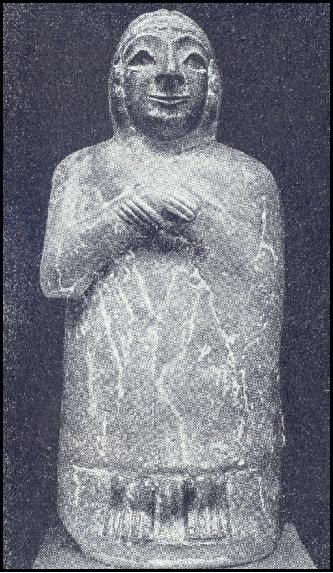
Left: Statue of a notable Sumerian. Lagash. Circa 2500 BC.
The statue shows a man with slightly obliquely-set eyes. This could be a sign of the cross-breading between Caucasoids and Mongoloids. This sign is expressed rather weakly and could be explained that Mongoloids left Sumeria some millenniums before.
Certainly, Sumerians were not Semites and E. T. Williams along with other scholars thought that they had some Turanian features and, therefore, came to such conclusion:
We have, then, the facts that various Chinese tribes appear to have come into what is now China from some region to the northwest of that country and that the Sumerians appear to have come into the Euphrates Valley from some places to the northeast of Babylonia; that the Sumerians were apparently of the Turanian race, and that their language and their script are strikingly like those of the ancient Chinese; and that extensive changes in the climate of Central Asia have driven out at different periods great numbers of the inhabitants who have migrated in various directions. It does not seem at all improbable that the Chinese forefathers and the ancestors of the Sumerians may have been related and may have migrated from neighboring regions, the Chinese toward the east and the Sumerians toward the west (WILLIAMS E.T., 1918: 211).
In our time, scholars comparing Chinese and Sumerian writing systems turn their attention more to their differences, as similarities and the theory about the West Asian origin of Chinese almost has no adherents. Obviously, a common attitude to this problem was expressed by John De Francis, an American sinologist:
… it seems to me that while some of the principles underlying Chinese writing are similar to those underlying Sumerian writing, in all probability the reason for this is not that one was influenced by the other. The distances in time and space, unlike the Sumerian-Egyptian and Phoenician-Greek situations.., militate against such a hypothesis. A more reasonable explanation is that the two people independently thought up somewhat similar solutions to somewhat similar problems (DEFRANCIS JOHN. 1989).
However, these distances could be shorter if the remains of Chinese ancestors stayed on their Urheimat in West Asia after the majority of them migrated eastward. The time of the stay of Sino-Tibetan people in their Urheimat should be attributed to the Upper Palaeolithic, because later this place was dwelt by the speakers of the Nostratic languages, which came here from the west, driving out the original inhabitants eastward and assimilating or killing what remained. The Sino-Tibetans moved to Central Asia, where they became the creators of the local Mesolithic cultures. They arrived at current places of habitat as early as the Neolithic or it was brought with them since neither in China nor Burma reliable traces of the Mesolithic period were not found.

Right:
Statue of a bearded priest from Mohenjo-daro.
Obviously, people of the Mongoloid race were living in Central Asia before the arrival of the Dravidians. They could be the creators of the Bronze Age civilizations, such as Harappa (centers – Rakhigarhy, Mohenjo-Daro, Harappa, Lotkhal, Dholavira in Pakistan and India) and the Bactria–Margiana Archaeological Complex (Gonur-Depe, Namazga-Tepe, and Altyndepe In Turkmenistan).
The Bactria-Margiana Archaeological Complex (BMAC), also named the Oxus Civilization, existed during the Middle and Late Bronze Age about half a millennium (ca. 2250–1700 BC) in Central Asia:
Its “core area” – where the bulk of its remains comes from – is situated in southern Central Asia (nowadays Turkmenistan, southern Uzbekistan, and Afghanistan), but similar cultural features are known on its outskirts, in Tadjikistan, central Uzbekistan (Zeravshan valley), and also far beyond, in a large part of eastern Iran and Baluchistan. In these surrounding “outer” zones most of the finds come from graveyards – now more and more numerous as research goes on – and only very few settlements have been recognized up to now (LYONNET BERTILLE and DUBOVA NADEZHDA A. 2021: 1)
The main sites of the Oxus Civilisation
(Ibid: 10, Figure 1.1)
(The numbers on the map indicate: 38 Namazga-Depe; 39 Altyn-Depe; 40 Geoksjur; 41 Togolok; 42 Kelleli; 43 Gonur-Depe; 44 Dashly-Tepe; 45 Bactra; 46 Sapallitepa; 47 Dzharkutan; 48 Zamanbaba; 49 Karnab (tin mines); 50 Sarazm; 51 Mushiston (tin mines); 52 Farkhor; 53 Shortughai; 54 Talugan)
This fully developed culture was included in a wide network of relations of various kinds that developed in the last centuries of the 3rd and the first centuries of the 2nd millennium between Anatolia, Mesopotamia, the Gulf, Elam, and the Indus Valley. Researchers have not noted any evidence of the presence of a writing system among the bearers of this culture but it must have been known to them in their connections with Mesopotamia. It is known that complex musical instruments, like the harp and the lyre, game board, and materials and techniques for making composite statuettes characteristic of this culture were widespread over a vast area from Syria to the Indus Valley (LUNEAU ELISE. 2021: 497-504). In that case, it is easy to suppose that the writing system was equally widespread in the same area. Its traces may have gone unnoticed by archaeologists due to the small number of settlements explored.
The latest phase of the Oxus Civilization is approximately positioned between 1800/1700 BC and 1500/1400 BC. However the chronology is imprecise, "mostly due to regional differences, the complexity of chronological subdivisions, and methodological issues" (Ibid: 497-498). The multiple transformations, "de-urbanization" in the Final Bronze Age have long been admitted interpretations of the last centuries of the Oxus Civilization as "collapse". However, this civilization disappeared step by step. The combination of several social, material, and mental changes allows us to speak about mutation as a multifaceted, overall, and deep evolution of the whole sociocultural system.
We know that the Indo-Aryans passed through Central Asia moving from their ancestral homeland to new places of residence (see The First Great Migration). This is confirmed by research on ancient DNA, which revealed that northern populations played a significant role in the genetic history of Central Asia due to the mixing of natives and aliens (Ibid: 515)
The Harappan civilization existed approximately in 3300-1300. BC, having emerged simultaneously with the Oxus Civilisation and ceased to exist half a millennium later. It can be assumed that their decline is associated with the arrival of the Indo-Aryan tribes in Central Asia. The presence of Mongoloid features in the sculptural portraits found during excavations of the monuments of these civilizations may indicate that the people of the Mongoloid race after their migration from the Near East had found places for settlements in the Indus valley and on the banks of the Murgab, the Amu Darya, and the Syr Darya Rivers. Apparently, under the pressure of the Indo-Aryans, they had to migrate farther to the east.

Women's sculptural busts from sites of Bactria–Margiana Archaeological Complex
Photo from Wikipedia.
It is clear that the Sino-Tibetans belong to the yellow race, which also belonged to the Indians of America and the peoples of the Mongolian and Manchu-Tungus language groups. Since the languages of these latter do not contain clear signs of kinship with the Sino-Tibetan, i.e., they were formed very far from the settlement of the Sino-Tibetans, we have to assume that people of the yellow race inhabited a vast area in Asia at the time when human language was at its initial phase of formation.
We adhere to the hypothesis of the monocentrism, according to which, a modern man emerged in the Near East and the Mediterranean as a result of the mixing of different representatives of the Neanderthal type. The typological heterogeneity of peoples of different races in the Upper Paleolithic was smaller than it is now. (SHCHOKIN HEORHIY, 2002: 77). In other words, the difference between the prototypes of Caucasoid and Mongoloid races were insignificant and they were living in the same environmental conditions of Southwest Asia. After the Mongoloids migrated along the broad expanse of Asia, their original phenotypic traits developed in different ways under the influence of natural conditions of different habitats. The result of their difference from the white race has increased, but at the same time two distinct racial types were developed, which gave rise to modern Mongoloids and Amerikanoids.


